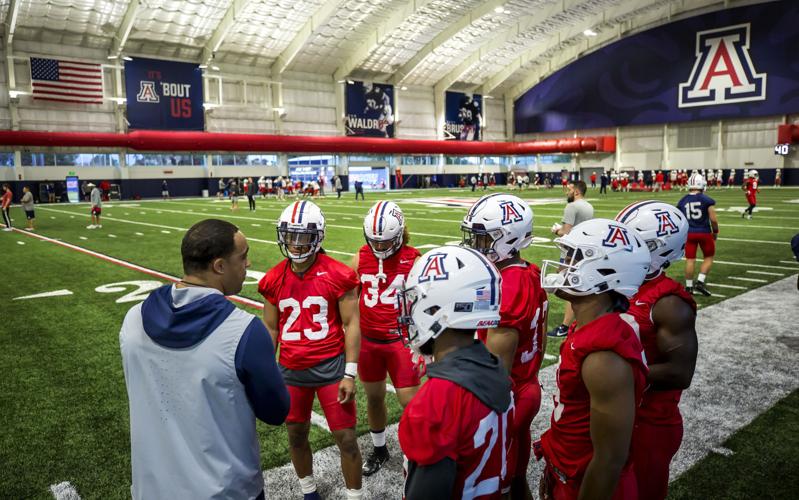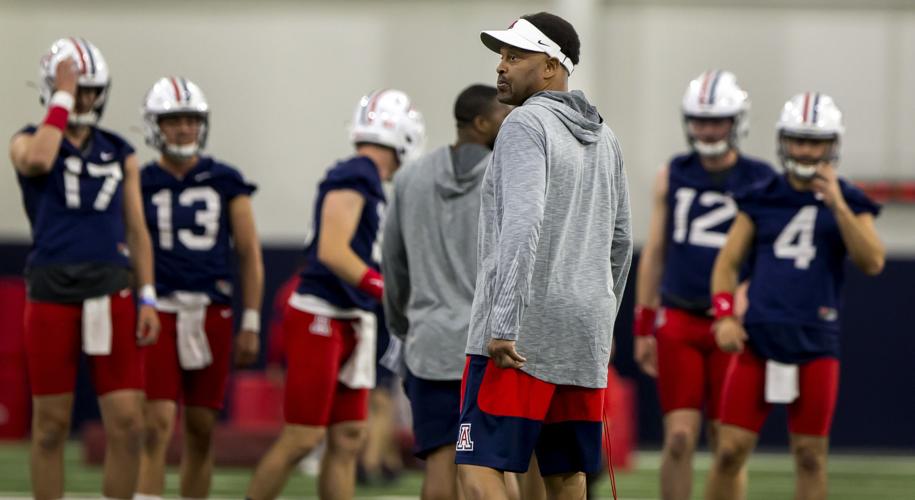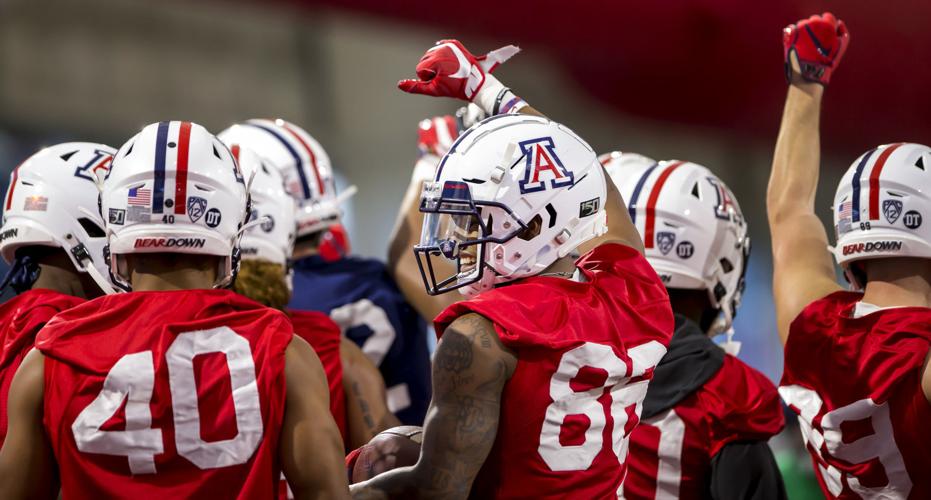The ‘’unity movement” announced by a small group of Pac-12 football players over the weekend is neither modest nor without worthy purpose. It demands changes in equality and economics. It insists on less risk and more reward.
It is a player’s manifesto that you could see coming from 3,000 miles away. One football player wrote: “We will not play until there is a real change that is acceptable to us.”
Such demand is overstated and overreaching and those threats aren’t likely to work. But it could start the process of true reform for players’ rights that is deserving and overdue.
The economic model of college sports is busted. The old “collegiate model” of the 20th century needs to be overhauled with the players getting more and the coaches and administrators less.
The scholarship athletes at Arizona and every Power 5 school have it good. It’s just that given the excessive spending — do you realize Arizona offensive coordinator Noel Mazzone, at $600,000 per year, was the 23rd highest-paid employee at the UA in the fiscal year 2019-20, making more than the department head of emergency medicine and the dean of the Eller College of Business — has led to a loose coalition of Pac-12 football players wanting their cut.
But let’s not feel sorry for the players. Here’s an example:
Lawi Lalang completed his junior year of eligibility at Arizona in June 2013 by winning his seventh NCAA distance running championship. He was, in my opinion, the UA’s leading athlete of the decade, 2010-19.
In almost any other college sport — basketball, football, baseball — a man of Lalang’s accomplishments would’ve left campus and turned pro.
Lalang could’ve chosen to compete in the Diamond League, a European-based pro track circuit and possibly made $50,000 or so. He surely would’ve been coveted by the prestigious Nike distance running organization, pocketing thousands over the summer. As such, I asked UA track coach Fred Harvey if he feared Lalang would not return for his senior season.
“He would have to give up his scholarship and pay to complete his degree; he would no longer receive free academic counseling or tutoring,” said Harvey. “He would no longer have access to free medical care, or physical therapy. He would have to hire a coach. He would have to pay his own travel expenses and for his food and lodging.”
All of those elements were covered by Lalang’s UA scholarship. He returned for his senior season, earned his degree, won an eighth NCAA championship and is overdue to be inducted into the UA Sports Hall of Fame.
So, no, I don’t buy it when 21 Pac-12 football players say, in a united voice, that they are being exploited physically, economically, and academically. There is a lot of good in college sports, and tens of thousands of student-athletes like Lawi Lalang have benefited from the collegiate system.
But this goes beyond the collegiate system and so-called amateurism rules, which seem mislabeled given that an athletic scholarship is worth as much as $50,000 a year to athletes like Lawi Lalang. Isn’t that enough?
I cannot speak to the group’s claims of racial injustice. if true, it is unforgivable and unacceptable. It is clearly time for Pac-12 institutions to intensify their anti-racism initiatives and fortify curriculum addressing institutional racism.
And I have no expertise in safety protocols for COVID-19 — the risks of a college football player would take if he chooses to participate in the 2020 season. As Oregon football player Jevon Holland said in The Players Tribune piece: “I refuse to put my body at risk for other’s benefits.”
This showdown — athletes vs. athletic departments — was inevitable. After months of racial unrest and the frightening and unprecedented spread of the coronavirus pandemic, the flaws in the college sports model have been examined and exposed. All that was needed was someone to light a fuse the way the Pac-12 football players did over the weekend.

Head coach Kevin Sumlin notes that the Wildcats got in four spring practices. “People forget about that. Some people didn’t have any.”
Some of the players’ demands are excessive and surely won’t be met. There is absolutely no chance that each school will be able to give 50% of their sports revenue to athletes. That would bankrupt everyone and eliminate women’s sports, which, given Title IX laws, would be illegal.
But college athletic departments should seriously consider guaranteeing athletic scholarships beyond a four-year eligibility period.
They should create extended insurance coverage beyond a young man’s final college football game, and they should obviously allow athletes to profit from their name, image and likeness — as soon as possible.
If UA All-American point guard Aari McDonald is offered $10,000 to do TV commercials for Hughes Federal Credit Union, there should be immediate clearance.
And there should be no hesitation to extend and guarantee the scholarship of a football player who opts not to play the 2020 season over fears that it will not be safe.
There is no “best for everyone” in this situation. Each player must make his own decision. And each school must do the right thing and respect the rights of the football players who wish not to put themselves in harm’s way.
I fear that the value of a traditional college degree is going to get lost in this maneuver by the Pac-12 football players to get a louder voice and more benefits. Yet some of their demands are no-brainers.
For example, Arizona and almost all Power 5 schools include academic bonuses in the contracts of many head coaches. The money for those academic bonuses can be better spent by adding to the athletes’ insurance coverage and to help meet their graduate degree expenses.
UA football coach Kevin Sumlin will be awarded a $50,000 bonus if the football team’s cumulative GPA is 2.6. The bonus continues to climb to as high as $200,000 if the team GPA averages 3.0.
Why should that money go to a football coach? Why not split it among the 85 scholarship football players, which would be about $2,350 each?
The UA athletic department paid $7.5 million to build the Clements Academic Center recently. It employs 15 people with a total payroll of almost $800,000 a year. Those are the people — not the coaches — who influence team GPAs. Paying a coach for academic performance is part of how the collegiate model became warped the last 25 years.
Get the money to the right people. That is much of the basis of the Pac-12 football players’ claims of being exploited. Provide that money for post-college medical treatments for those who tear an ACL or suffer a back injury while playing football.
If each athletic department began trimming the fat — eliminating disposable luxuries such as staying in 5-star hotels and taking a private jet for basketball games in Los Angeles — there would be enough to take care of an injured football players’ back injury after he leaves school.
That should be at the heart of college athletics, not building a locker room fitting of the Taj Mahal.
The future of college athletes is sure to change. The amateurism model may have worked in 1985, but that’s when the UA was paying basketball coach Lute Olson $60,000 a year. If someone is going to get $200,000 for a team’s academic performance, it shouldn’t go to a coach whose base salary is $2.5 million.
For the first time in history, college athletics have unprecedented leverage. They have a voice. They have unity. This is just the beginning.






